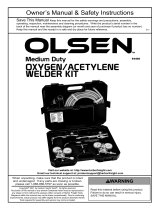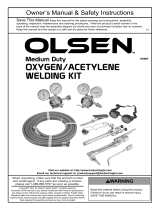Page is loading ...

OPERATING INSTRUCTIONS for
F-9372-P
May, 2000
Be sure this information reaches the operator.
You can get extra copies through your supplier.
These INSTRUCTIONS are for experienced operators. If you are not fully familiar with the principles of operation and safe
practices for oxy-fuel gas equipment, we urge you to read our booklet "Precautions and Safe Practices for Gas Welding,
Cutting and Heating," Form 2035. Do NOT permit untrained persons to install, operate, or maintain this equipment. Do NOT
attempt to install or operate this equipment until you have read and fully understand these Instructions. If you do not fully
understand these Instructions, contact your supplier for further information.
HALIDE LEAK DETECTORS
MODEL I (SUPER SENSITIVITY) PART NO. 10X32
MODEL II (STANDARD SENSITIVITY) PART NO. 11X16
PREST-0-LITE Halide Leak Detec-
tors are designed for locating leaks
of noncombustible halide reffigerant
gases (sold under the brand names
“Freon,” “Ucon,” etc.) used in refrig-
erating and air- conditioning systems.
The supersensitive Model Detector
will detect the presence of as little as
20 parts per million of these reffigerant
gases. The Model II Detector will de-
tect 100 parts of halide gas per mil-
lion parts of air. (The Model I and
Model II detectors are generally simi-
lar in appearance. The Model 1, how-
ever, has wings alongside the open-
ing in the flame shield; the Model 11
does not.)
Setting Up:
The leak detector is normally used
with a standard PREST-0-LITE torch
handle (either Type 401 or Type 403)
equipped with shut-off valve. Acety-
lene can be supplied from a “B” tank
(40 cu. ft.) or an MC tank (10 cu. ft.).
In either case, the tank must be
equipped with a pressure-reducing
regulator, such as the PREST-0-LITE
R-411, and the torch handle con-
nected to the regulator by a suitable
length of fitted acetylene hose.
In making set-up, be sure all seating
surfaces are clean before assem-
bling, and tighten all connections se-
curely, using a wrench to tighten hose
and regulator connections. Be sure to
a small acetylene tank can often be
corrected by tightening the packing
nut with a wrench. If this will not stop
the leak, remove the tank, tag it to in-
dicate valve stem leakage, and place
it outdoors in a safe spot until you can
return it to your supplier.)
Adjusting the Flame:
1. With the inlet end of the suction
hose placed so that it is unlikely to
draw in air contaminated with refrig-
erant vapor, adjust the needle valve
on the torch handle until the pale blue
outer envelope of the flame extends
about one inch above the reactor
plate. The inner cone of the flame,
which should also be visible above the
reaction plate, should be clear and
sharply defined.
follow the instructions supplied with
the torch handle and regulator.
Lighting:
1. Open the tank valve, using a P-O-L
tank key (Part No. 505LOO), one
quarter turn.
2. Be sure the shut-off valve on the
torch handle is closed. Then adjust
the regulator to deliver 10 psi by turn-
ing in the pressure-adjusting screw
until the “C” marking on the flat sur-
faces of the screw is opposite the face
of the front cap. Then test for leaks
(see next section on “Leak-Testing the
Set-Up”).
3. Open the torch handle shut-off
valve and light the gas, above the re-
action plate, with a match or taper.
Leak-Testing the Set-Up:
Using a thick solution of soap and
water, applied with a small brush, test
ACETYLENE
HOSE
SUCTION
HOSE
TANK
VALVE
NEEDLE
VALVE
HANDLE
REGULATOR
for leaks at the (tank valve), at the
(regulator-to-tank) connection, and
at the (regulator-to-hose) and
(hose-to-handle) connections. If you
find a leak, correct it before you light
up. (A leak around the valve stem of

F-9372-P 5/2000 Printed in U.S.A.
If the outer envelope of the flame,
when of proper length, is yellow, not
pale-blue, you’re either picking up re-
frigerant vapors (see “Leak Detect-
ing”) or there is probably some ob-
struction in the flow of air to the flame.
Make sure the suction tube isn’t
clogged or bent sharply. If the suction
tube is clear, shut off the flame, close
the tank valve, disconnect the leak
detector from handle, and check for
dirt in the filter screw or mixer disc.
Use a 1/8-in. socket key (Allen
wrench) to remove or replace the fil-
ter screw, which retains the mixer
disc.
Detecting Leaks:
1. Explore for leaks by moving the end
of the suction hose around all points
where a leak might occur. Be careful
not to kink the suction hose.
2. Watch for color changes in the
flame as you move the end of the
suction hose. These are the changes
which you should look for:
With the Model I Detector (large open-
ing in flame shield, with wings on each
side): a small leak will change the
color of the outer flame to a yellow or
orange-yellow hue. As the concentra-
tion of halide gas increases, the yel-
low will disappear. The lower part of
the flame will become a bright, light
blue, and the top of the flame will be-
come a vivid purplish blue.
With the Model H Detector (no
wings alongside the flame shield
opening): Small concentrations of
halide gas will change the color of the
outer flame to a bright blue-green. As
the concentration of halide gas in-
creases, the lower part of the flame
will lose its greenish tint, and the up-
per portion will become a vivid pur-
plish blue.
3. Watch for color intensity changes.
The location of small leaks can be
pinpointed readily, since the color in
the flame will disappear almost in-
stantly after the intake end ofthe suc-
tion hose has passed the point of leak-
age. With larger leaks, you’ll have to
judge the point of leakage in terms of
the color change from yellow to
purple-blue (Model 1) or blue-green
to blue-purple (Model II).
IMPORTANT: In the course of time
and intensive usage, an oxide scale
may form on the surface of the reac-
tion plate, thus reducing its sensitiv-
ity, remove the reaction plate and
scrape its surface with a knife or
screwdriver blade, or install a new
plate.
REACTION PLATE ASSEMBLY - 50Y86
INCLUDES
SCREW, NO. 8-32 X 3/16”
SHIELD - 68Z59
SCREW -
NO. 8-32 X 3/16”
(IICLUDED IN 50Y86)
SLEEVE - 68Z61
WASHER - 68Z68
BUSHING - 37Z85
MIXER/STEM ASSY. -
08Y06
INCLUDES
FILTER SCREW - 998311
MIXER DISC - 150Z47
Model I - P/N 10X32
REACTION PLATE ASSEMBLY - 52Z80
INCLUDES
SCREW, NO. 8-32 X 3/16”
SHIELD - 52Z79
SCREW -
NO. 8-32 X 3/16”
(IICLUDED IN 52Z80)
SLEEVE - 68Z61
WASHER - 68Z68
BUSHING - 37Z85
MIXER/STEM ASSY. -
60Y41
INCLUDES
FILTER SCREW - 998311
MIXER DISC - 162Z40
REPLACEMENT PARTS
Model II - P/N 11X16
/



